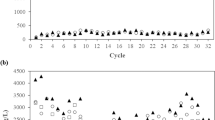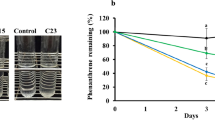Abstract
The indigenous microorganisms responsible for degrading phenanthrene (PHE) in activated biosludge were identified using DNA-based stable isotope probing. Besides the well-known PHE degraders Burkholderia, Ralstonia, Sinobacteraceae and Arthrobacter, we for the first time linked the taxa Paraburkholderia and Kaistobacter with in situ PHE biodegradation. Analysis of PAH-RHDα gene detected in the heavy DNA fraction of 13C-PHE treatment suggested the mechanisms of horizontal gene transfer or inter-species hybridisation in PAH-RHD gene spread within the microbial community. Additionally, three cultivable PHE degraders, Microbacterium sp. PHE-1, Rhodanobacter sp. PHE-2 and Rhodococcus sp. PHE-3, were isolated from the same activated biosludge. Among them, Rhodanobacter sp. PHE-2 is the first identified strain in its genus with PHE-degrading ability. However, the involvement of these strains in PHE degradation in situ was questionable, due to their limited enrichment in the heavy DNA fraction of 13C-PHE treatment and lack of PAH-RHDα gene found in these isolates. Collectively, our findings provide a deeper understanding of the diversity and functions of indigenous microbes in PHE degradation.





Similar content being viewed by others
References
Amann RI, Ludwig W, Schleifer KH (1995) Phylogenetic identification and in situ detection of individual microbial cells without cultivation. Microbiol Rev 59:143–169
Arulazhagan P, Sivaraman C, Kumar SA, Aslam M, Banu JR (2014) Co-metabolic degradation of benzo(e)pyrene by halophilic bacterial consortium at different saline conditions. J Environ Biol 35:445–452
Bahr A, Fischer A, Vogt C, Bombach P (2015) Evidence of polycyclic aromatic hydrocarbon biodegradation in a contaminated aquifer by combined application of in situ and laboratory microcosms using (13)C-labelled target compounds. Water Res 69:100–109
Bates ST, Berglyons D, Caporaso JG, Walters WA, Knight R, Fierer N (2011) Examining the global distribution of dominant archaeal populations in soil. ISME J 5:908
Breznak JA (2002) A need to retrieve the not-yet-cultured majority. Environ Microbiol 4:4–5
Cámara B, Herrera C, González M, Couve E, Hofer B, Seeger M (2004) From PCBs to highly toxic metabolites by the biphenyl pathway. Environ Microbiol 6:842–850
Cebron A, Norini MP, Beguiristain T, Leyval C (2008) Real-time PCR quantification of PAH-ring hydroxylating dioxygenase (PAH-RHDalpha) genes from Gram positive and Gram negative bacteria in soil and sediment samples. J Microbiol Methods 73:148–159
Cebron A, Louvel B, Faure P, France-Lanord C, Chen Y, Murrell JC, Leyval C (2011) Root exudates modify bacterial diversity of phenanthrene degraders in PAH-polluted soil but not phenanthrene degradation rates. Environ Microbiol 13:722–736
Chen WM, Laevens S, Lee TM, Coenye T, De VP, Mergeay M, Vandamme P (2001) Ralstonia taiwanensis sp. nov., isolated from root nodules of Mimosa species and sputum of a cystic fibrosis patient. Int J Syst Evol Microbiol 51:1729–1735
Coenye T, Vandamme P (2003) Diversity and significance of Burkholderia species occupying diverse ecological niches. Environ Microbiol 5:719–729
Ding GC, Heuer H, Zuhlke S, Spiteller M, Pronk GJ, Heister K, Kogel-Knabner I, Smalla K (2010) Soil type-dependent responses to phenanthrene as revealed by determining the diversity and abundance of polycyclic aromatic hydrocarbon ring-hydroxylating dioxygenase genes by using a novel PCR detection system. Appl Environ Microbiol 76:4765–4771
Dumont MG, Murrell JC (2005) Stable isotope probing—linking microbial identity to function. Nat Rev Microbiol 3:499–504
Ferraro DJ, Gakhar L, Ramaswamy S (2005) Rieske business: structure-function of Rieske non-heme oxygenases. Biochem Biophys Res Commun 338:175–190
Gao Z, Yuan Y, Xu L, Liu R, Chen M, Zhang C (2016) Paraburkholderia caffeinilytica sp. nov., isolated from the soil of a tea plantation. Int J Syst Evol Microbiol 66:4185–4190
Guentas L, Gensous S, Cavaloc Y, Ducousso M, Amir H, Georges De, de Ledenon B, Moulin L, Jourand P (2016) Burkholderia novacaledonica sp. nov. and B. ultramafica sp. nov. isolated from roots of Costularia spp. pioneer plants of ultramafic soils in New Caledonia. Syst Appl Microbiol 39:151–159
Gutierrez T (2011) Identifying polycyclic aromatic hydrocarbon-degrading bacteria in oil-contaminated surface waters at Deepwater Horizon by cultivation, stable isotope probing and pyrosequencing. Rev Environ Sci Bio 10:301–305
Gutierrez T, Green DH, Nichols PD, Whitman WB, Semple KT, Aitken MD (2012) Polycyclovorans algicola gen. nov., sp. nov., an aromatic-hydrocarbon-degrading marine bacterium found associated with laboratory cultures of marine phytoplankton. Appl Environ Microbiol 79:205–214
Gutierrez T, Singleton DR, Berry D, Yang T, Aitken MD, Teske A (2013) Hydrocarbon-degrading bacteria enriched by the Deepwater Horizon oil spill identified by cultivation and DNA-SIP. ISME J 7:2091–2104
Hu QW, Chu X, **ao M, Li CT, Yan ZF, Hozzein WN, Kim CJ, Zhi XY, Li WJ (2016) Arthrobacter deserti sp. nov., isolated from a desert soil sample. Int J Syst Evol Microbiol 66:2035–2040
Jameson E, Taubert M, Coyotzi S, Chen Y, Eyice Ö, Schäfer H, Murrell JC, Neufeld JD, Dumont MG (2017) DNA-, RNA-, and protein-based stable-isotope probing for high-throughput biomarker analysis of active microorganisms. Springer, New York
Jiang L, Song M, Luo C, Zhang D, Zhang G (2015) Novel phenanthrene-degrading bacteria identified by DNA-stable isotope probing. PLoS ONE 10:e0130846
Zhang J-L, Ma Y-P, Wu Z-K, Dong K, Zheng S-L, Wang Y-Y (2017) Natural hybridization and introgression among sympatrically distributed Rhododendron species in Guizhou, China. Biochem Syst Ecol 70:268–273
Jones MD, Crandell DW, Singleton DR, Aitken MD (2011) Stable-isotope probing of the polycyclic aromatic hydrocarbon-degrading bacterial guild in a contaminated soil. Environ Microbiol 13:2623–2632
Keith LH, Telliard WA (1979) Priority Pollutants: I. A perspective view. Environ Sci Technol 13:416–423
Kim J-D, Shim S-H, Lee C-G (2005) Degradation of phenanthrene by bacterial strains isolated from soil in oil refinery fields in Korea. J Microbiol Biotechnol 15:337–345
Kozdrój J, Elsas JDV (2000) Response of the bacterial community to root exudates in soil polluted with heavy metals assessed by molecular and cultural approaches. Soil Biol Biochem 32:1405–1417
Kumar W, Lakshmi C, Khanna S (2008) Biodegradation and bioremediation of endosulfan contaminated soil. Bioresour Technol 99:3116–3122
Lebaron P, Servais P, Agogue H, Courties C, Joux F (2001) Does the high nucleic acid content of individual bacterial cells allow us to discriminate between active cells and inactive cells in aquatic systems? Appl Environ Microbiol 67:1775–1782
Ledin A, Patureau D (2010) Xenobiotics in the urban water cycle. Springer, Dordrecht
Li J, Liu J, Shen W, Zhao X, Hou Y, Cao H, Cui Z (2010) Isolation and characterization of 3,5,6-trichloro-2-pyridinol-degrading Ralstonia sp. strain T6. Bioresour Technol 101:7479–7483
Li J, Luo C, Song M, Dai Q, Jiang L, Zhang D, Zhang G (2017) Biodegradation of phenanthrene in polycyclic aromatic hydrocarbon-contaminated wastewater revealed by coupling cultivation-dependent and -independent approaches. Environ Sci Technol 51:3391–3401
Liu X, Zhang S, Jiang Q, Bai Y, Shen G, Li S, Ding W (2016) Using community analysis to explore bacterial indicators for disease suppression of tobacco bacterial wilt. Sci Rep 6:36773
Luo CL, **e SG, Sun WM, Li XD, Cupples AM (2009) Identification of a novel toluene-degrading bacterium from the candidate phylum TM7, as determined by DNA stable isotope probing. Appl Environ Microbiol 75:4644–4647
Makarenkov V, Boc A, Legendre P (2014) A new algorithm for inferring hybridization events based on the detection of horizontal gene transfers clusters, orders, and trees: methods and applications. Springer, New York, pp 273–293
Minai-Tehrani D, Minoui S, Herfatmanesh A (2009) Effect of salinity on biodegradation of polycyclic aromatic hydrocarbons (PAHs) of heavy crude oil in soil. Bull Environ Contam Toxicol 82:179–184
Navarro-Noya YE, Jan-Roblero J, del Carmen González-Chávez M, Hernández-Gama R, Hernández-Rodríguez C (2010) Bacterial communities associated with the rhizosphere of pioneer plants (Bahia xylopoda and Viguiera linearis) growing on heavy metals-contaminated soils. Anton Leeuw Int J G 97:335–349
Nogi Y, Yoshizumi M, Hamana K, Miyazaki M, Horikoshi K (2014) Povalibacter uvarum gen. nov., sp. nov., a polyvinyl-alcohol-degrading bacterium isolated from grapes. Int J Syst Evol Microbiol 64:2712–2717
Oren A (2004) Prokaryote diversity and taxonomy: current status and future challenges. Philos Trans R Soc Lond B 359:623–638
Radeva G, Kenarova A, Bachvarova V, Flemming K, Popov I, Vassilev D, Selenska-Pobell S (2013) Bacterial diversity at abandoned uranium mining and milling sites in Bulgaria as revealed by 16S rRNA genetic diversity study. Water Air Soil Pollut 224:1748
Ryan MP, Pembroke JT, Adley CC (2006) Ralstonia pickettii: a persistent gram-negative nosocomial infectious organism. J Hosp Infect 62:278–284
Sawana A, Adeolu M, Gupta RS (2014) Molecular signatures and phylogenomic analysis of the genus Burkholderia: proposal for division of this genus into the emended genus Burkholderia containing pathogenic organisms and a new genus Paraburkholderia gen. nov. harboring environmental species. Front Genet 5:429
Schwarzenbach RP, Escher BI, Fenner K, Hofstetter TB, Johnson CA, Gunten UV, Wehrli B (2006) The challenge of micropollutants in aquatic systems. Science 313:1072–1077
Singh BK, Walker A (2006) Microbial degradation of organophosphorus compounds. FEMS Microbiol Rev 30:428–471
Singleton DR, Powell SN, Sangaiah R, Gold A, Ball LM, Aitken MD (2005) Stable-isotope probing of bacteria capable of degrading salicylate, naphthalene, or phenanthrene in a bioreactor treating contaminated soil. Appl Environ Microbiol 71:1202–1209
Song M, Luo C, Jiang L, Zhang D, Wang Y, Zhang G (2015) Identification of benzo[a]pyrene-metabolizing bacteria in forest soils by using DNA-based stable-isotope probing. Appl Environ Microbiol 81:7368–7376
Wongwongsee W, Chareanpat P, Pinyakong O (2013) Abilities and genes for PAH biodegradation of bacteria isolated from mangrove sediments from the central of Thailand. Mar Pollut Bull 74:95–104
Yabuuchi E, Kosako Y, Yano I, Hotta H, Nishiuchi Y (1995) Transfer of two Burkholderia and an Alcaligenes species to Ralstonia gen. Nov.: proposal of Ralstonia pickettii (Ralston, Palleroni and Doudoroff 1973) comb. Nov., Ralstonia solanacearum (Smith 1896) comb. Nov. and Ralstonia eutropha (Davis 1969) comb. Nov. Microbiol Immunol 39:897–904
Yabuuchi E, Kosako Y, Oyaizu H, Yano I, Hotta H, Hashimoto Y, Ezaki T, Arakawa M (2013) Proposal of Burkholderia gen. nov. and transfer of seven species of the genus pseudomonas homology group II to the new genus, with the type species Burkholderia cepacia (Palleroni and Holmes 1981) comb. nov. Microbiol Immunol 36:1251–1275
Zhang D, Berry JP, Zhu D, Wang Y, Chen Y, Jiang B, Huang S, Langford H, Li G, Davison PA, Xu J, Aries E, Huang WE (2015) Magnetic nanoparticle-mediated isolation of functional bacteria in a complex microbial community. ISME J 9:603–614
Zhaxybayeva O, Lapierre P, Gogarten JP (2004) Genome mosaicism and organismal lineages. Trends Genet 20:254–260
Acknowledgements
Financial support was provided by the National Natural Science Foundation of China (Nos. 41673111 & 41603072) and the Scientific and Technological Planning Project of Guangzhou, China (Nos. 201707020034 & 201510010038).
Author information
Authors and Affiliations
Corresponding author
Electronic supplementary material
Below is the link to the electronic supplementary material.
Rights and permissions
About this article
Cite this article
Li, J., Zhang, D., Song, M. et al. Novel bacteria capable of degrading phenanthrene in activated sludge revealed by stable-isotope probing coupled with high-throughput sequencing. Biodegradation 28, 423–436 (2017). https://doi.org/10.1007/s10532-017-9806-9
Received:
Accepted:
Published:
Issue Date:
DOI: https://doi.org/10.1007/s10532-017-9806-9




